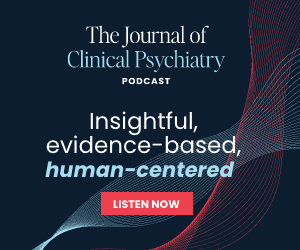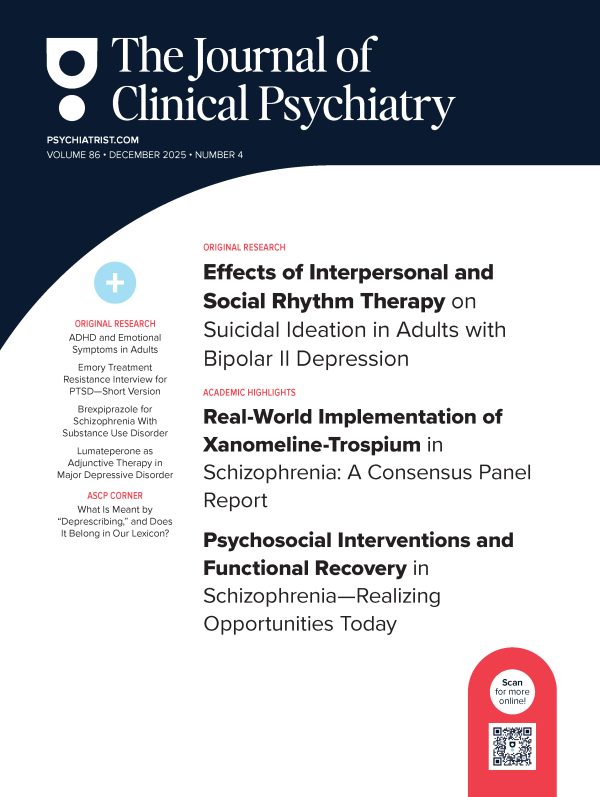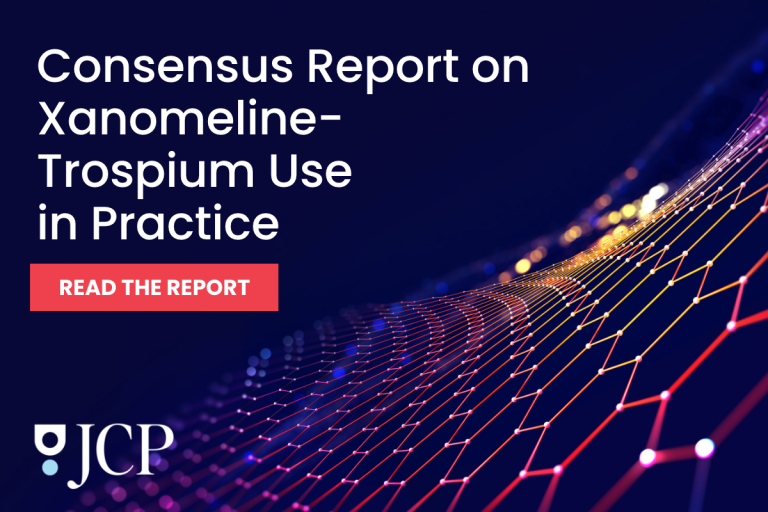See related article by Meisner et al
The discovery of ketamine’s rapid-acting antidepressant effects has been hailed as the greatest breakthrough in depression research in 60 years.1 Because the market exclusivity of racemic ketamine has long ago expired, it is unlikely that a sponsor would conduct the necessary clinical trials to gain Food and Drug Administration (FDA) approval as a therapy for depression or other psychiatric disorders. Esketamine, the S-enantiomer delivered intranasally, was approved in 2019 and 2020 for treatment-resistant depression (TRD) and major depression with suicidal ideation, respectively, on the basis of several phase 3 clinical trials.2–4
The treatment development program of esketamine was guided by the understanding of the field at the time that N-methyl-D-aspartate (NMDA) receptor antagonism was the driving mechanism underlying ketamine’s antidepressant effects.5 The decision was made to develop the S-enantiomer (esketamine) instead of racemic ketamine or the R-enantiomer (arketamine) because esketamine is about 4–5 times more potent at the NMDA receptor than the R-enantiomer.
While racemic ketamine is not FDA-approved for any psychiatric indication, it is increasingly used off-label as a treatment for patients with depression or other psychiatric disorders. Most commonly, racemic ketamine is delivered intravenously. Despite the fact that esketamine and racemic ketamine are quite similar from a biochemical perspective, there remains significant controversy in the field as to whether there is a meaningful clinical difference between esketamine and ketamine.
Against this background, Meisner and colleagues report clinical outcomes from a cohort of 153 patients with TRD treated with either ketamine or esketamine at the McLean Hospital. The report from McLean documents that patients treated with intravenous ketamine (N = 111) had greater improvement than those treated with intranasal esketamine (N = 42), with a 49.2% improvement in symptoms compared to 39.6%, respectively. Response and remission rates were not reported nor were systematic evaluations of adverse events.
This report by Meisner and colleagues6 adds to 2 additional reports of outcomes among patients receiving ketamine or esketamine in the same clinical settings using real-world data. Nikayin et al7 reported real-world clinical outcomes of 210 treatment-seeking patients at Yale. While there was no group difference in terms of response or remission rates, the ketamine group had slightly better improvements in depressive symptoms at the end of the treatment period.7 Another observational study (N = 62) of patients with TRD treated at Mayo found no group differences in terms of baseline-to-end point change in depression severity nor response/ remission rates; however, time to remission (defined as number of treatments) was faster for intravenous ketamine.8
Retrospective cohort studies such as these that used real-world clinical data have value, though also significant limitations. Rigorous and systematic evaluation of adverse events is usually not possible in clinical settings. Providing a thorough and standardized clinical and demographic characterization of patients that allows for subsequent and rigorous analyses is also challenging in clinical settings.
But the most critical weakness of such reports is that treatments were not randomly assigned. As a result, unmeasured variables may confound differences in clinical outcomes. In the case of real-world reports from nonrandomized cohorts attempting to evaluate efficacy differences between ketamine and esketamine, the most likely potential confounders are socioeconomic factors (eg, insurance coverage and income level).
Generally, intranasal esketamine has much broader insurance coverage compared to intravenous ketamine. (Most private clinics do not have any insurance coverage for intravenous ketamine, and patients must pay cash). Because of this, all else being equal, the average patient receiving ketamine will be of higher socioeconomic status than the average patient receiving esketamine. Because higher socioeconomic status is generally linked with better health outcomes, it is possible that any observed difference in clinical outcomes between patients receiving ketamine and esketamine is solely attributable to underlying differences in socioeconomic status and not because of a difference in treatment efficacy. While the McLean Hospital does have some insurance coverage for intravenous ketamine, the present analysis does not report measures of socioeconomic status or attempt to control for them. Prior similar reports (including from our own group) are also limited in their inability to measure or control for socioeconomic status as key potential confounders.7,8
To our knowledge, there has only been 1 randomized trial comparing ketamine and esketamine for TRD (N = 63).9 Notably, this study used intravenous esketamine, as opposed to the now FDA-approved formulation of intranasal esketamine. Further limiting the generalizability of this study, outcomes were assessed after only a single dose of drug. (In real-world practice, patients generally receive multiple doses over the course of several weeks, months, or even years, because a single dose is often short-lived and many patients relapse within 2 weeks following a single dose).10–13 Notwithstanding these limitations, this study showed that there were no differences in remission or response rates for up to 1-week postdose.
Given that the study of highest quality design showed no difference in intravenous ketamine or esketamine and that reports using real-world data have been unable to adequately account for socioeconomic status as a key potential confounder, there remains genuine uncertainty as to the comparative efficacy of these 2 treatments. This uncertainty notwithstanding, there are real logistical factors that affect the comparative safety of the treatments from a public health perspective.
As esketamine is approved by the FDA, it is subject to a strict drug safety program (Risk and Evaluation Mitigation Strategy [REMS]) that prohibits take-home dosing and limits the dose and frequency of exposure. Ketamine is off-label for any psychiatric illness and hence is not subject to REMS requirements. This difference reflects a loophole in the regulation of health care and is not (as some clinicians erroneously infer) an indication of differential safety of the treatments. Because of this logistical difference, esketamine is demonstrably safer from a public health perspective.
Recent data from the Rocky Mountain Poison and Drug Safety Center have shown that rates of esketamine abuse are extremely low and have not measurably changed, whereas rates of ketamine abuse have steadily risen from 2016 to 2023.14 While these data cannot account for the phenomenon whereby patients treated with esketamine later seek racemic ketamine illicitly, it clearly shows that esketamine itself is quite safe from an abuse perspective because of the strict regulations that govern its use.
The REMS program prohibits at-home esketamine use, whereas at-home use of racemic ketamine has become more prominent in reports of study journals and news media.15,16 This logistical difference further contributes to greater public safety of esketamine compared to ketamine. The high-profile case of Matthew Perry, whose death was caused in part by ketamine, exemplifies this.
Neurotoxicity is another potential adverse effect where the esketamine REMS program protects public health. Neurotoxicity has been repeatedly demonstrated in preclinical experiments of rodents and primates exposed to varying doses of ketamine.17–20 Irreversible cognitive impairment has also been documented in humans who misuse ketamine at high doses and frequencies.21,22 This literature clearly shows that dose, frequency, and cumulative exposure mediate the risk of neurotoxicity. The long-term esketamine trial (accumulating 3,777 person-years of esketamine exposure) has shown a relatively safe cognitive profile when esketamine is used at approved doses and frequencies.23 In contrast, racemic ketamine regimens of doses exceeding 2 mg/kg per dose (roughly equivalent to more than 3 times the maximum esketamine dose) or daily dosing have been reported24,25 and are permissible because of the lack of REMS oversight.
Hence, in terms of safety, esketamine has a safer public health profile for purely logistical reasons. Notwithstanding the current report from Meisner and colleagues,6 legitimate uncertainty remains regarding the comparative efficacy of the 2 drugs. An ongoing, well-powered comparative effectiveness study (NCT06713616)26 should provide a more definitive answer to this question, though study results will not be available until 2028 at the earliest. In the meantime, there is evidence that both ketamine and esketamine can be helpful in managing TRD,27 though clinicians should closely approximate the esketamine REMS program restrictions if they choose to use ketamine off-label for depression or related disorders.
Article Information
Published Online: September 22, 2025. https://doi.org/10.4088/JCP.25com16003
© 2025 Physicians Postgraduate Press, Inc.
J Clin Psychiatry 2025;86(4):25com16003
Submitted: June 17, 2025; accepted June 18, 2025.
To Cite: Wilkinson ST, Rhee TG. Ketamine and esketamine: is there a meaningful clinical difference? J Clin Psychiatry 2025;86(4):25com16003.
Author Affiliations: Yale Depression Research Program, Department of Psychiatry, Yale School of Medicine, New Haven, Connecticut (Wilkinson, Rhee).
Corresponding Author: Samuel T. Wilkinson, MD, Yale Depression Research Program, Department of Psychiatry, Yale School of Medicine, 100 York St, STE 2J, New Haven, CT 06511 ([email protected]).
Relevant Financial Relationships: In the last 36 months, Dr Wilkinson has received contract research funding from Oui Therapeutics for the conduct of clinical trials (administered through Yale University). He has consulted or provided data and safety monitoring board services for LivaNova, Mind Medicine, Neumora, Sooma Medical, and Joyous. Dr Rhee reports no disclosures.
References (27)

- Duman RS. Ketamine and rapid-acting antidepressants: a new era in the battle against depression and suicide. F1000Res. 2018;7: F1000 Faculty Rev-1659.
- Kim J, Farchione T, Potter A, et al. Esketamine for treatment-resistant depression—first FDA-approved antidepressant in a new class. New Engl J Med. 2019;381(1):1–4.
- Ionescu DF, Fu D-J, Qiu X, et al. Esketamine nasal spray for rapid reduction of depressive symptoms in patients with major depressive disorder who have active suicide ideation with intent: results of a phase 3, double-blind, randomized study (ASPIRE II). Int J Neuropsychopharmacol. 2021;24(1):22–31.
- Fu D-J, Ionescu DF, Li X, et al. Esketamine nasal spray for rapid reduction of major depressive disorder symptoms in patients who have active suicidal ideation with intent: double-blind, randomized study (ASPIRE I). J Clin Psychiatry. 2020;81(3):6605.
- Li N, Lee B, Liu R-J, et al. mTOR-dependent synapse formation underlies the rapid antidepressant effects of NMDA antagonists. Science. 2010;329(5994):959–964. PubMed CrossRef
- Meisner R, Li S, Boyle B, et al. Comparative effects of repeated ketamine infusion vs intranasal esketamine in patients with treatment resistant depression: a retrospective chart review. J Clin Psychiatry. 2025;86(4):25m15789.
- Nikayin S, Rhee TG, Cunningham ME, et al. Evaluation of the trajectory of depression severity with ketamine and esketamine treatment in a clinical setting. JAMA psychiatry. 2022;79(7):736–738.
- Singh B, Kung S, Pazdernik V, et al. Comparative effectiveness of intravenous ketamine and intranasal esketamine in clinical practice among patients with treatment-refractory depression: an observational study. J Clin Psychiatry. 2023;84(2):45331.
- Correia-Melo FS, Leal GC, Vieira F, et al. Efficacy and safety of adjunctive therapy using esketamine or racemic ketamine for adult treatment-resistant depression: a randomized, double-blind, non-inferiority study. J Affect Disord. 2020;264:527–534. PubMed CrossRef
- Berman RM, Cappiello A, Anand A, et al. Antidepressant effects of ketamine in depressed patients. Biol Psychiatry. 2000;47(4):351–354.
- Zarate CA, Singh JB, Carlson PJ, et al. A randomized trial of an N-methyl-D-aspartate antagonist in treatment-resistant major depression. Archives Gen Psychiatry. 2006;63(8):856–864. PubMed CrossRef
- Diazgranados N, Ibrahim L, Brutsche NE, et al. A randomized add-on trial of an N-methyl-D-aspartate antagonist in treatment-resistant bipolar depression. Archives Gen Psychiatry. 2010;67(8):793–802. PubMed CrossRef
- Zarate Jr CA, Brutsche NE, Ibrahim L, et al. Replication of ketamine’s antidepressant efficacy in bipolar depression: a randomized controlled add-on trial. Biol Psychiatry. 2012;71(11):939–946. PubMed CrossRef
- Dart RC. Can mind-altering prescription medicines be safe? Lessons from ketamine and esketamine. Clin Toxicol. 2024;62(8):477–482.
- Pacilio RM, Parikh SV, Geller J. Outpatient ketamine prescribing practices in psychiatry in the United States: a Nationwide Survey Study. J Clin Psychiatry. 2025;86(3):25m15809.
- Banov MD, Landrum RE. The online, At-Home ketamine experience: a clinician’s dilemma. Psychiatr Times. 2022;39(10).
- Olney JW, Labruyere J, Price MT. Pathological changes induced in cerebrocortical neurons by phencyclidine and related drugs. Science. 1989;244(4910):1360–1362. PubMed CrossRef
- Liu F, G Paule M, Ali S, et al. Ketamine-induced neurotoxicity and changes in gene expression in the developing rat brain. Curr Neuropharmacol. 2011;9(1):256–261. PubMed CrossRef
- Sun Z, Ma Y, Xie L, et al. Behavioral changes and neuronal damage in rhesus monkeys after 10 weeks of ketamine administration involve prefrontal cortex dopamine D2 receptor and dopamine transporter. Neuroscience. 2019;415:97–106.
- Sun L, Li Q, Li Q, et al. Chronic ketamine exposure induces permanent impairment of brain functions in adolescent cynomolgus monkeys. Addict Biol. 2014;19(2):185–194. PubMed CrossRef
- Morgan CJ, Muetzelfeldt L, Curran HV. Consequences of chronic ketamine self-administration upon neurocognitive function and psychological wellbeing: a 1-year longitudinal study. Addiction. 2010;105(1):121–133. PubMed CrossRef
- Morgan CJ, Monaghan L, Curran HV. Beyond the K-hole: a 3-year longitudinal investigation of the cognitive and subjective effects of ketamine in recreational users who have substantially reduced their use of the drug. Addiction. 2004;99(11):1450–1461. PubMed CrossRef
- Zaki N, Chen L, Lane R, et al. Safety and efficacy with esketamine in treatment-resistant depression: long-term extension study. Int J Neuropsychopharmacol. 2025;28(6):pyaf027.
- O’Brien B, Wilkinson ST, Mathew SJ. An update on community ketamine practices. Am J Psychiatr. 2022;179(5):393–394.
- Wilkinson ST, Toprak M, Turner MS, et al. A survey of the clinical, off-label use of ketamine as a treatment for psychiatric disorders. Am J Psychiatr. 2017;174(7):695–696.
- ClinicalTrials.gov. PCORI Comparative Effectiveness Study-Esketamine (Spravato) vs. Ketamine-Equivalence Study. 2025. Accessed July 15, 2025. https://www.clinicaltrials.gov/study/NCT06713616
- McIntyre RS, Rosenblat JD, Nemeroff CB, et al. Synthesizing the evidence for ketamine and esketamine in treatment-resistant depression: an international expert opinion on the available evidence and implementation. Am J Psychiatr. 2021;178(5):383–399.
This PDF is free for all visitors!





